![]()
![]()
![]()
Use LEFT and RIGHT arrow keys to navigate between flashcards;
Use UP and DOWN arrow keys to flip the card;
H to show hint;
A reads text to speech;
82 Cards in this Set
- Front
- Back
|
What are leaves |
the photosynthetic factories of the plant |
|
|
What are the function of leaves? |
Leaves are needed for photosyntehesis. They produce food for the whole plant |
|
|
What are the two parts of the leaf |
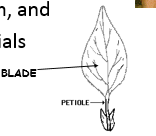
1)Blade 2) Petiole |
|
|
Blade |
Flat expanded area of the leaf |
|
|
Petiole |
The stalk that connects the leaf blade to the stem and transports materials |
|
|
Describe the leaf epidermis |
It is transparent and contains a waxy cuticle |
|
|
What is the purpose of the transparency of the epidermis |
This allows sunlight to go through the leaf |
|
|
What is the purpose of the waxy cuticle of the leaf |
It protects the plant from drying out |
|
|
What are the parts of the lower epidermis |
The stomata with guard cells |
|
|
Whats the purpose of the stomata with guard cells |
The y allow gas exchange of co2 h20 and 02 |
|
|
What is vascular tissue? |
Vascular tissue is a complex conductingtissue, formed of more than one cell type, found in vascular plants. |
|
|
What are the vascular tissue of plants collectively called? |
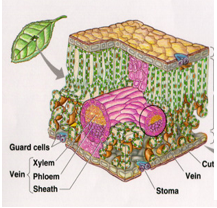
Veins |
|
|
What are the 3 parts of the veins of a plant |
1)xylem 2)phloem 3) bundle sheaths |
|
|
Xylem of the leaf |
Water transport |
|
|
Phloem of the leaf |
food transport |
|
|
bundle sheaths of the leaf |
cells surrounding the xylem/phloem for strength and support |
|
|
What is the mesophyll of the leaf |
The middle of the leaf |
|
|
What is the mesyphyll in the leaf made of |
photosynthetic ground cells |
|
|
What are the two types of photosynthetic ground cells |
1) Palisade parenchyma 2) Spongy parenchya |
|
|
Palisade parenchyma |
long columns below the epidermis that have a lots of chloroplast for photosyntehsis |
|
|
Spongy parenchym |
spherical cells with air spaces around for gas exchange. |
|
|
What are stems |
Organs of the plant that are usually found above groudn |
|
|
What are the 2 purposes of stems |
1)To support the leaves and fruit 2) to conduct water and sugars throughout the plant ( from the xylem and phloem)
|
|
|
What are the tree parts of the stem vascular tissue |
1) The vascular bundles 2) Xylem 3)Phloem |
|
|
Vascualr bundles in stems |
composed of both xylem and phloem |
|
|
Xylem in stems |
Conducts water also important for support |
|
|
Phloem in stems |
Conducts food also important for support |
|
|
Vascular cambium in stems |
lateral meristem in vascular tissue |
|
|
Meristem cells in stems |
Tissue in most plants containing undifferentiated cells |
|
|
Epidermis in stems |
Dermal tissue type |
|
|
What is the purpose of the epidermis in stems
|
Provides protection |
|
|
What is the purpose of the cuticle in stems |
to prevent wter loss |
|
|
What is the purpose of trichomes in stems |
the hairs are for protection, they release scents oils, etc..... |
|
|
What are the three types of tissues in the stem |

1) epidermis 2)Cuticle (wax) 3) Trhichomes (hairs) |
|
|
What are roots |
The hidden half of the plant |
|
|
What is the function of roots |
1) Ancorage 2) Absorption of water and dissolved minerals 3) Storage (surplus sugars, starch) 4) Conduction water/ nutrients |
|
|
What are the 3 divisors of the root |
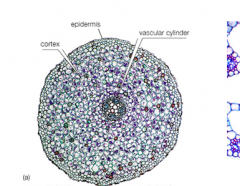
1) Epidermis 2) Cortex 3) Vascualr cylinder |
|
|
What are the 4 parts of the vascular cylinder |
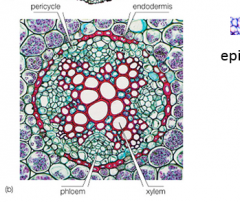
1) pericycle 2) endodermis 3)phloem 4)Xylem
|
|
|
What are the 4 types of roots |
1) Tap root 2) Adventitious Roots 3) Aerial Roots 4) Fibrous Roots |
|
|
What is a tap root |
A root system where there is 1 main root, that is the continuation of the primary root T |
|
|
What are the 3 functions of this root |
1) Anchorage 2) greatest penetration for water. 3) Food storage. |
|
|
What is the primary root? |
the first root produced by a germinating seed, developing from the radicle of the embryo. |
|
|
What is the Fibrous root |
Many finely branched secondary roots. These roots are shallow and cover a large area |
|
|
What are fibrous roots effective for |
1) it has a very effecient absorption of water and minerals 2) The roots hold the soil to prevent erosion. |
|
|
What are aerial roots |
Roots that grow above ground |
|
|
What are the two types of aerial roots |
1) clinging air roots 2)Absorptive air roots |
|
|
Clinging air roots |
Short roots that grow horizontally from the stems. These roots fasten the plant to a support |
|
|
Absorptive air roots |
These roots absorb moisture from the air. |
|
|
Adventitios roots |
Roots developed in places other than the nodes. They form on cuttings for example the leaf or fruit of a plant. |
|
|
What is another name for the ground tissue in roots |
The cortex |
|
|
What is the function of the cortex in roots |
It provides support and often stores sugars and starch |
|
|
What is the outermost single layer of the root cell called |
The root epidermis |
|
|
What are the 2 purposes of the root epidermis |
1) protects the plant from diseases 2) Absorbs water and nutrients |
|
|
What are root hairs |
tubular extentions of epidermal cells |
|
|
What is the purpose of root hair |
it increases surface area of root, for better water/nutrient absorption |
|
|
What is the xylem in roots |
Long cells with thick wall cotnaining lignin |
|
|
What is the purpose of lignin |
lignin waterproofs walls of cells and strengthens them |
|
|
What is the purpose of the xylem in the roots |
It transports and and dissolved minerals |
|
|
How is the xylem formed |
Cells die and the ends decay forming a long tube, the lignin forms a sprial, annular rings or broken rings (reticulate), some lignification is not complete and pores are left called pits or bordered pits. this allows water to move between vessels or into living parts of the plant. |
|
|
What are the 5 parts of the water conducting cells of the xylem in the roots |
1) tracheids 2) vessel elements 3) pits 4) fibres for support 5) living parenchyma cells |
|
|
Tracheids in the roots |
long, thin tube like structures without perforations at the ends
|
|
|
Vessel elements in roots |
Short, wide tubes perforated at the ends (together from a pipe called vessel) |
|
|
Pits |
A thin section on the walls of the tracheids and the vessel elements |
|
|
fibres in the xylem |
support |
|
|
Is the xylem dead or a live? |
The xylem consist of dead cells. they are hollow and consist only of a cell wall.
|
|
|
What are the 5 adaptation of the xylem |
1) made of dead cells forming continuous columns 2) tubes are narrow so capilarry action is effective 3) Pits allow water to move sideways 4) lignin is strong and allows for stretching 5) flow of water is not impeded as: there are no end walls, no cell contents, no nucleus, lignin prevents tubes collapsing. |
|
|
What are the 4 parts of the phloem in the roots |

1) sieve plate 2) sieve tube member 3) companion cell 4) phloem parenchyma |
|
|
What is the purpsoe of the phloem |
To transport organic materials ( sugars) |
|
|
are the cells of the phloem alive or dead? |
alive however they lack a nucleus and organelles |
|
|
sieve tube members |
STM - the tube that the nutrients travel through |
|
|
Companion cells |
join sieve tube members and help to laod materials into stm |
|
|
sieve plates |
end walls of te sieve tube members having large pores |
|
|
Sieve tube elements |
not true cells because they have little cytoplasm |
|
|
How is a tube formed? |
the sieve tube elements line up end to end |
|
|
How is the sugar in the tube dissolved |
Sucrose is dissolved in water to form a sap. |
|
|
Describe 4 characteristics of the companion cells |
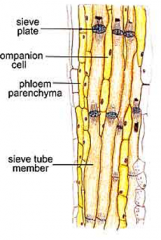
1) Large nucleus 2) dense cytoplasm 3) many mitochondria to load sucrose into sieve cells 4) Many plasmodesmata |
|
|
What are plasmodesmata |
gaps in cells walls between companion cells and sieve tubes for flow of minerals. |
|
|
Describe the 5 characteristics of the plasmalemma |
1) up to 50% phospholipid 2) up to 50% protein 3) forms a bialyer in water 4) impermeable to msot charged particles 5) made in the endoplasmic reticulum, chloroplast and mitochondria |
|
|
Describe the protein in the plasma membrane |
some are fixed and some can move about within the cell. |
|
|
What is the 4 functions of the protein in the plasma membrane |
1Transporting molecules into and out of the cell 2) maintain cell structure 3) act as receptors 4) take part in chemical reactions as enzymes |
|
|
What is the general purpose of the protein vs lipids in the plasmalemma |
proteins: determine the shape and function of the cell lipids: form the phospholipid bilayer which controls what enters the cell |
|
|
What is the function of the phospholipid bilayer |
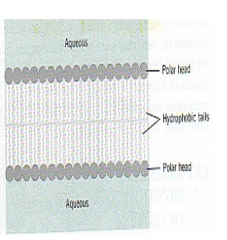
phospholipids, which have a phosphate head and a fatty acid tail. Phosphate heads are water soluble while the tails are not. The phospholipids are arranged in the membrane so that the water soluble heads point toward the watery extracellular environment and the aqueous cytoplasm make up the inside of the cell. The tail ends, which are not water soluble, are oriented together in the middle of the membrane. |

